13 Sep 2023 — Rescuing Zeugma from the floodwaters of the Euphrates

In Spring 2000 an archaeological drama began to unfold on the banks of the Euphrates river in Turkey, close to the border with Syria. A small team of French and Turkish archaeologists found a Roman city on the banks of the river, with mosaics and wall-paintings finer than those of Pompeii. However, just beside them was the almost completed Birecik Dam, and the Turks had begun to flood the great reservoir behind it, taking the city under water. This lecture tells the story of the extraordinary archaeological rescue excavation that then took place (racing against the inexorable waters for four and a half months as they rose at a rate of two feet a day) and the fabulous treasures recovered, including mosaic floors (arguably the finest ever found) depicting colourful scenes from myth and legend.
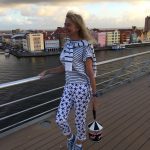 Lecturer: Louise Schofield is an archaeologist who was Curator of Greek Bronze Age and Geometric Antiquities at the British Museum from 1987-2000. Her book, The Mycenaeans, was co-published by the Getty Museum and the British Museum in 2007. She now writes, lectures and runs international archaeological projects – previously in south-eastern Turkey, Greece and Albania and currently in Ethiopia. And rather wonderfully she has been appointed Visiting Professor of Archaeology at the American University of Rome.
Lecturer: Louise Schofield is an archaeologist who was Curator of Greek Bronze Age and Geometric Antiquities at the British Museum from 1987-2000. Her book, The Mycenaeans, was co-published by the Getty Museum and the British Museum in 2007. She now writes, lectures and runs international archaeological projects – previously in south-eastern Turkey, Greece and Albania and currently in Ethiopia. And rather wonderfully she has been appointed Visiting Professor of Archaeology at the American University of Rome.
11 Oct 2023 — The Valois dukes of Burgundy: dazzling and dastardly
 Few dynastic families in western Europe wielded such power or wealth in the late Middle Ages as the Dukes of Burgundy. With territories stretching as far as the Low countries, theirs was a sumptuous court to rival all others. But they would prove dastardly as well as dazzling and nothing would stop them from their ultimate goal. In this lecture Carole will follow their rise to glory and creation of their own superpower and consider the associated trappings of such a flamboyant lifestyle; such as art, fashion and gastronomy.
Few dynastic families in western Europe wielded such power or wealth in the late Middle Ages as the Dukes of Burgundy. With territories stretching as far as the Low countries, theirs was a sumptuous court to rival all others. But they would prove dastardly as well as dazzling and nothing would stop them from their ultimate goal. In this lecture Carole will follow their rise to glory and creation of their own superpower and consider the associated trappings of such a flamboyant lifestyle; such as art, fashion and gastronomy.
 Lecturer: Carole Petipher is an experienced guide and lecturer on combined history and art tours in France with 20 years experience. Having lived and worked on a number of bespoke river vessels and converted barges there she has used them as a platform from which to research her lectures. She uses art in all its guises to explore the characters who shaped France and likes to delve behind the scenes to discover hidden truths.
Lecturer: Carole Petipher is an experienced guide and lecturer on combined history and art tours in France with 20 years experience. Having lived and worked on a number of bespoke river vessels and converted barges there she has used them as a platform from which to research her lectures. She uses art in all its guises to explore the characters who shaped France and likes to delve behind the scenes to discover hidden truths.
8 Nov 2023 — Tamara de Lempicka: Art Deco diva
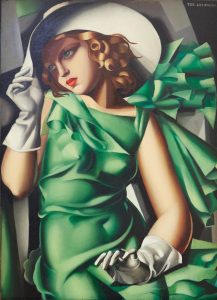 Tamara de Lempicka’s story is one of self-invention. From her early beginnings as an aristocratic fugitive from the Russian Revolution, to later taking Paris by storm as a successful artist living on her own terms, she has become an icon of the Roaring Twenties. Her unique style reflects the shifting morals of the age, representative of the wealthy and decadent European elite, and boldly celebrating female sexuality. Few artists sum up an epoch quite as completely. She is a true art deco diva.
Tamara de Lempicka’s story is one of self-invention. From her early beginnings as an aristocratic fugitive from the Russian Revolution, to later taking Paris by storm as a successful artist living on her own terms, she has become an icon of the Roaring Twenties. Her unique style reflects the shifting morals of the age, representative of the wealthy and decadent European elite, and boldly celebrating female sexuality. Few artists sum up an epoch quite as completely. She is a true art deco diva.
 Lecturer: Alexandra Epps is an official guide and lecturer at Tate Modern, Tate Britain and Guildhall Art Gallery. She is a qualified Guide to the City of London, offering lectures and walks about many aspects of the arts for societies, corporations and private individuals. Alexandra is a member of the City of London Guide Lecturers Association and co-author of the book Lord Mayor’s Portraits 1983-2014 (2015). Alexandra’s background is in design, having practised as a graphic designer running her own design consultancy for many years. She has a BA Saint Martin’s School of Art and an MA London College of Printing.
Lecturer: Alexandra Epps is an official guide and lecturer at Tate Modern, Tate Britain and Guildhall Art Gallery. She is a qualified Guide to the City of London, offering lectures and walks about many aspects of the arts for societies, corporations and private individuals. Alexandra is a member of the City of London Guide Lecturers Association and co-author of the book Lord Mayor’s Portraits 1983-2014 (2015). Alexandra’s background is in design, having practised as a graphic designer running her own design consultancy for many years. She has a BA Saint Martin’s School of Art and an MA London College of Printing.
13 Dec 2023 — Entertaining angels unawares: angels in the Bible, music and art
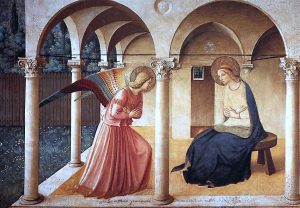 Angels don’t speak, they sing. And they have inspired much wonderful music. This talk will investigate their roles as guardians, messengers and fighters through imaginative music by Britten, Elgar and Mendelssohn. Angelic words also feature in regularly repeated liturgical texts that are sung daily in St Paul’s Cathedral, such as the Sanctus and Te Deum. These will give us an opportunity to explore and enjoy angelic music by composers such as Bach, Mozart and Walton. We will call on some of the world’s finest art and poetry to further expand this journey into the heavenly realm.
Angels don’t speak, they sing. And they have inspired much wonderful music. This talk will investigate their roles as guardians, messengers and fighters through imaginative music by Britten, Elgar and Mendelssohn. Angelic words also feature in regularly repeated liturgical texts that are sung daily in St Paul’s Cathedral, such as the Sanctus and Te Deum. These will give us an opportunity to explore and enjoy angelic music by composers such as Bach, Mozart and Walton. We will call on some of the world’s finest art and poetry to further expand this journey into the heavenly realm.
 Lecturer: Patrick Craig is a Vicar Choral at St Paul’s Cathedral. For twenty years he combined this with an international career singing over a thousand concerts with the world-renowned early music consort The Tallis Scholars. He also sings with the award-winning group The Cardinal’s Musick. He founded and conducts the UK’s leading all-female professional choir, Aurora Nova. He has conducted concerts for the BBC Proms, the Brighton, Lichfield and Aldeburgh Festivals and with the City of London Sinfonia.
Lecturer: Patrick Craig is a Vicar Choral at St Paul’s Cathedral. For twenty years he combined this with an international career singing over a thousand concerts with the world-renowned early music consort The Tallis Scholars. He also sings with the award-winning group The Cardinal’s Musick. He founded and conducts the UK’s leading all-female professional choir, Aurora Nova. He has conducted concerts for the BBC Proms, the Brighton, Lichfield and Aldeburgh Festivals and with the City of London Sinfonia.
As a Cambridge history graduate with a lifelong interest in the arts, Patrick has gone on to lead choral workshops for amateur singers across the world, where he places music in its historical and cultural context. He regularly lectures for the St Paul’s Adult Education programme and for John Hall’s Venice Courses, which have allowed him to incorporate his interests in theology, art and poetry.
In 2020, when his singing and conducting work disappeared overnight as a result of the Covid pandemic, Patrick poured all his experience into online presentations which have raised vital funds for the Help Musicians Charity.
10 Jan 2024 — George Villiers, Duke of Buckingham: the handsomest man in 17th Century Europe and his patronage of the arts
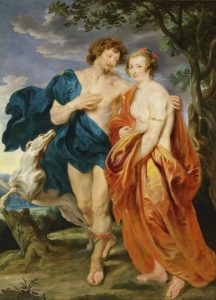 George Villiers, Duke of Buckingham, was the favourite of King James I – who addressed him as ‘my sweet child and wife’ – and subsequently chief minister to King Charles I. Buckingham was a beauty and he surrounded himself with beautiful things. He enjoyed exquisite clothes, like the fabulous white silk suit encrusted with diamonds that he wore to visit the Queen of France. He was a superb dancer. When he cut capers during a court masque King James startled visiting ambassadors by shouting out ‘By God, George, I love you!’ He was a discerning patron. Inigo Jones renovated his houses. John Tradescant was his garden designer. In his great house on the Strand he put together a collection of art works as fine as King Charles’s. At the age of 35 Buckingham was murdered. His collection was scattered, but contemporary inventories allow us to reconstruct it. This talk will show you some of the magnificent paintings he owned – the Titians, the Tintorettos, the Veroneses. But Buckingham was not just a collector of old masters: he was also a patron, commissioning boldly innovative new work. Most remarkable are the portraits of himself that he commissioned from painters including Van Honthorst, Van Dyck and Rubens – images by great artists of a man known as ‘the handsomest-bodied man in Europe’.
George Villiers, Duke of Buckingham, was the favourite of King James I – who addressed him as ‘my sweet child and wife’ – and subsequently chief minister to King Charles I. Buckingham was a beauty and he surrounded himself with beautiful things. He enjoyed exquisite clothes, like the fabulous white silk suit encrusted with diamonds that he wore to visit the Queen of France. He was a superb dancer. When he cut capers during a court masque King James startled visiting ambassadors by shouting out ‘By God, George, I love you!’ He was a discerning patron. Inigo Jones renovated his houses. John Tradescant was his garden designer. In his great house on the Strand he put together a collection of art works as fine as King Charles’s. At the age of 35 Buckingham was murdered. His collection was scattered, but contemporary inventories allow us to reconstruct it. This talk will show you some of the magnificent paintings he owned – the Titians, the Tintorettos, the Veroneses. But Buckingham was not just a collector of old masters: he was also a patron, commissioning boldly innovative new work. Most remarkable are the portraits of himself that he commissioned from painters including Van Honthorst, Van Dyck and Rubens – images by great artists of a man known as ‘the handsomest-bodied man in Europe’.
 Lecturer: Lucy Hughes-Hallett is a cultural historian and biographer. Her book on Gabriele d’Annunzio, The Pike, was described in The Sunday Times as ‘the biography of the decade’. It won all three of the UK’s most prestigious prizes for non-fiction – the Samuel Johnson Prize, the Duff Cooper Prize and the Costa Biography Award. Her other non-fiction books include Cleopatra and Heroes. She also writes fiction. Her novel, Peculiar Ground, is largely set in the 17th century, and narrated by a landscape designer loosely based on the great diarist John Evelyn. It was described as ‘almost Tolstoyan in its sly wit and descriptive brilliance’ (The Guardian) and ‘full of drama, vivid characters, wit, gorgeous writing and fascinating detail’. (New York Times). In her short story collection, Fabulous, she retells fables from classical mythology, relocating them to modern Britain. Lucy is a Fellow of the Royal Society of Literature and of the Historical Association. She has written on books, theatre and the visual arts for publications including The Sunday Times, The Guardian, The Observer, The New Statesman and the TLS. She was Chair of the Judges for the 2021 International Booker Prize.
Lecturer: Lucy Hughes-Hallett is a cultural historian and biographer. Her book on Gabriele d’Annunzio, The Pike, was described in The Sunday Times as ‘the biography of the decade’. It won all three of the UK’s most prestigious prizes for non-fiction – the Samuel Johnson Prize, the Duff Cooper Prize and the Costa Biography Award. Her other non-fiction books include Cleopatra and Heroes. She also writes fiction. Her novel, Peculiar Ground, is largely set in the 17th century, and narrated by a landscape designer loosely based on the great diarist John Evelyn. It was described as ‘almost Tolstoyan in its sly wit and descriptive brilliance’ (The Guardian) and ‘full of drama, vivid characters, wit, gorgeous writing and fascinating detail’. (New York Times). In her short story collection, Fabulous, she retells fables from classical mythology, relocating them to modern Britain. Lucy is a Fellow of the Royal Society of Literature and of the Historical Association. She has written on books, theatre and the visual arts for publications including The Sunday Times, The Guardian, The Observer, The New Statesman and the TLS. She was Chair of the Judges for the 2021 International Booker Prize.
14 Feb 2024 — Renaissance marriage and mythology
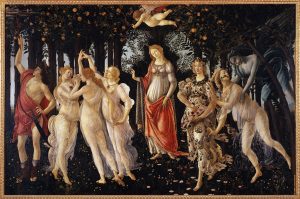 Taking one mythological work from each of the three major Italian cities; Venice, Florence, and Rome, this talk will explore the extraordinary secrets of Renaissance marriage. Giorgione’s Sleeping Venus, Botticelli’s Primavera and Raphael’s Galatea show the differences between each city, their attitudes towards brides, ideals of love and even bizarre anatomical beliefs. With such a focused analysis of just three works of art, the talk will uncover the politics, personalities and sex lives of the Renaissance rich and famous. Many images contain nudity, and the talk includes the topics of conception, sexual violence, and masturbation.
Taking one mythological work from each of the three major Italian cities; Venice, Florence, and Rome, this talk will explore the extraordinary secrets of Renaissance marriage. Giorgione’s Sleeping Venus, Botticelli’s Primavera and Raphael’s Galatea show the differences between each city, their attitudes towards brides, ideals of love and even bizarre anatomical beliefs. With such a focused analysis of just three works of art, the talk will uncover the politics, personalities and sex lives of the Renaissance rich and famous. Many images contain nudity, and the talk includes the topics of conception, sexual violence, and masturbation.
 Lecturer: Helen Oakden is the Head of the History of Art Department at St Mary’s School Ascot. She studied at Manchester University and achieved her Master’s Degree in architectural history from the Courtauld Institute of Art. Based in London she has previously worked for the Royal Academy and National Gallery, as well as leading specialised art history courses across Italy.
Lecturer: Helen Oakden is the Head of the History of Art Department at St Mary’s School Ascot. She studied at Manchester University and achieved her Master’s Degree in architectural history from the Courtauld Institute of Art. Based in London she has previously worked for the Royal Academy and National Gallery, as well as leading specialised art history courses across Italy.
13 Mar 2024 — Cultural experiments in the Weimar Republic
 After World War I, artists and architects were in a state of flux, just like the world they inhabited. How could they create and what, indeed, would they produce in a Europe still reeling from the worst conflict ever known? Yet out of crisis came a truly stimulating period of artistic endeavour. Contemplating painters such as Max Beckmann, Otto Dix and Christian Schad, alongside the experiments of the Bauhaus, new film technologies and the sultry stylings of Marlene Dietrich, this talk looks at the culture of German-speaking Europe during the interwar years.
After World War I, artists and architects were in a state of flux, just like the world they inhabited. How could they create and what, indeed, would they produce in a Europe still reeling from the worst conflict ever known? Yet out of crisis came a truly stimulating period of artistic endeavour. Contemplating painters such as Max Beckmann, Otto Dix and Christian Schad, alongside the experiments of the Bauhaus, new film technologies and the sultry stylings of Marlene Dietrich, this talk looks at the culture of German-speaking Europe during the interwar years.
 Lecturer: Gavin Plumley is a writer and broadcaster, appearing on BBC Radio 3, BBC Radio 4 and contributing to newspapers, magazines and opera and concert programmes worldwide. He lectures widely about the culture of Central Europe during the 19th and 20th centuries. Recent talks include the Royal Opera House, the National Gallery, the National Trust, the National Theatre, the British Museum, the V&A, the Southbank Centre, the Tate and the Neue Galerie, New York. Gavin’s first book, A Home for All Seasons, was published in June 2022.
Lecturer: Gavin Plumley is a writer and broadcaster, appearing on BBC Radio 3, BBC Radio 4 and contributing to newspapers, magazines and opera and concert programmes worldwide. He lectures widely about the culture of Central Europe during the 19th and 20th centuries. Recent talks include the Royal Opera House, the National Gallery, the National Trust, the National Theatre, the British Museum, the V&A, the Southbank Centre, the Tate and the Neue Galerie, New York. Gavin’s first book, A Home for All Seasons, was published in June 2022.
10 Apr 2024 — Art in miniature: illuminated Books of Hours in the late Middle Ages
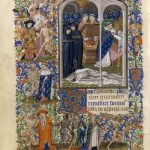 A familiar image of the Virgin Mary reading a book in a mediaeval annunciation scene: but what exactly is she supposed to be reading? A devotional book, probably, and perhaps one with beautiful decorations: intricate initials, miniatures glittering with gold, and witty marginalia. The illuminators themselves have often remained anonymous, yet their artistry was greatly prized by wealthy patrons such as the Duke of Berry. This talk offers an introduction to mediaeval manuscript illumination – an art so rich and so highly regarded that it long managed to survive the advent of book printing.
A familiar image of the Virgin Mary reading a book in a mediaeval annunciation scene: but what exactly is she supposed to be reading? A devotional book, probably, and perhaps one with beautiful decorations: intricate initials, miniatures glittering with gold, and witty marginalia. The illuminators themselves have often remained anonymous, yet their artistry was greatly prized by wealthy patrons such as the Duke of Berry. This talk offers an introduction to mediaeval manuscript illumination – an art so rich and so highly regarded that it long managed to survive the advent of book printing.
 Lecturer: Sophie Oosterwijk was born in Gouda, Netherlands. She has an MA and PhD in English Literature (Leiden), an MA in Mediaeval Studies (York) and a PhD in Art History (Leicester). Sophie has taught at the universities of St Andrews, Leicester and Manchester, at Sotheby’s Institute of Art, National Trust, V&A, U3A, WEA and other organisations, and she has organised many study days, tours and visits. Sophie is also a regular lecturer for Cambridge University and travel companies and is Vice President of the Church Monuments Society. She has written numerous publications.
Lecturer: Sophie Oosterwijk was born in Gouda, Netherlands. She has an MA and PhD in English Literature (Leiden), an MA in Mediaeval Studies (York) and a PhD in Art History (Leicester). Sophie has taught at the universities of St Andrews, Leicester and Manchester, at Sotheby’s Institute of Art, National Trust, V&A, U3A, WEA and other organisations, and she has organised many study days, tours and visits. Sophie is also a regular lecturer for Cambridge University and travel companies and is Vice President of the Church Monuments Society. She has written numerous publications.
8 May 2024 — The men who made menswear
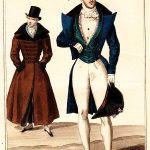 This lecture tells the story of men’s tailoring over the past 200 years, told through the lives of the men who commissioned and created and wore it. Tailors, shirtmakers, hatters and other craftspeople in London’s West End, especially around Savile Row and Jermyn Street, have shaped the way men dress since the Regency. How did men such as Beau Brummell, The Duke of Windsor, Tommy Nutter, Montague Burton, Alexander McQueen and John Stephen create their signature looks which influenced the men’s fashion? This lecture also looks at the wider cultural shifts since the early 19th century to the present day and how they affected the way that men present themselves.
This lecture tells the story of men’s tailoring over the past 200 years, told through the lives of the men who commissioned and created and wore it. Tailors, shirtmakers, hatters and other craftspeople in London’s West End, especially around Savile Row and Jermyn Street, have shaped the way men dress since the Regency. How did men such as Beau Brummell, The Duke of Windsor, Tommy Nutter, Montague Burton, Alexander McQueen and John Stephen create their signature looks which influenced the men’s fashion? This lecture also looks at the wider cultural shifts since the early 19th century to the present day and how they affected the way that men present themselves.
Lecturer: Russell Nash trained and worked as an actor, writer, puppeteer and theatre maker for 15 years. In 2015 he qualified a London Blue Badge Tourist Guide. Around this time he rekindled his love of art and art history. He now regularly guides the major galleries and museums in London such as the National Gallery, Tates Modern & Britain and the British Museum. He has delivered lectures for institutes and museums, as well as numerous U3A groups and other societies. During Covid lockdowns he devised and delivered more than 30 different virtual tours and lectures to groups from the UK and across the globe.
Picture from Wikimedia Commons
12 Jun 2024 — The divine sunflower in art and culture
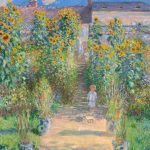 Worshipped by aesthetes and cultivated by impressionists, the sunflower casts its golden rays across art and culture. A personification of the divine and the regal, we trace its history from classical myth to 20th century painting via Van Dyck and Van Gogh, Clytie and Klimt, Monet, Rivera, Wilde and Watts. Green and gold, human and divine, the adoring and the adored, the Sunflower.
Worshipped by aesthetes and cultivated by impressionists, the sunflower casts its golden rays across art and culture. A personification of the divine and the regal, we trace its history from classical myth to 20th century painting via Van Dyck and Van Gogh, Clytie and Klimt, Monet, Rivera, Wilde and Watts. Green and gold, human and divine, the adoring and the adored, the Sunflower.
 Lecturer: Twigs Way is a professional researcher and writer fascinated by the past and intrigued by the role of flowers, gardens and landscape in art and culture of all kinds. Her work explores themes of symbolism and meaning, class and gender, art and literature, and she enjoys following lesser known paths in garden history towards the unexpected. Her original work was on the history of women in the garden and she retains an active research interest in this topic. Recent publications include the art and culture of specific flowers including the carnation and the daffodil and her book The Chrysanthemum in Art and Culture was published October 2020 by Reaktion Press. Twigs is currently working on the Daffodil in art and culture.
Lecturer: Twigs Way is a professional researcher and writer fascinated by the past and intrigued by the role of flowers, gardens and landscape in art and culture of all kinds. Her work explores themes of symbolism and meaning, class and gender, art and literature, and she enjoys following lesser known paths in garden history towards the unexpected. Her original work was on the history of women in the garden and she retains an active research interest in this topic. Recent publications include the art and culture of specific flowers including the carnation and the daffodil and her book The Chrysanthemum in Art and Culture was published October 2020 by Reaktion Press. Twigs is currently working on the Daffodil in art and culture.
18 Sep 2024 — AGM and Jewel in the Crown: the Sainte Chapelle in Paris
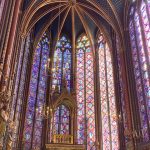 The Sainte Chapelle is a gem of beauty and technical innovation in the heart of Paris, possibly the most perfect surviving mediaeval ensemble. It was designed not only to celebrate France and its kings, but as a life-size reliquary, a worthy shrine for some of the most significant and talismanic of Christian remains, including the Crown of Thorns. Built in a mere five years (1243-1248), this extraordinary survivor captures the best of the arts at a precise moment in time, summoned up by all the resources available to a king. This lecture looks at the architecture, the sculpture but, above all, the exquisite stained glass, setting Louis IX in the company of the blessed and turning the interior into a floating vision of heaven on earth.
The Sainte Chapelle is a gem of beauty and technical innovation in the heart of Paris, possibly the most perfect surviving mediaeval ensemble. It was designed not only to celebrate France and its kings, but as a life-size reliquary, a worthy shrine for some of the most significant and talismanic of Christian remains, including the Crown of Thorns. Built in a mere five years (1243-1248), this extraordinary survivor captures the best of the arts at a precise moment in time, summoned up by all the resources available to a king. This lecture looks at the architecture, the sculpture but, above all, the exquisite stained glass, setting Louis IX in the company of the blessed and turning the interior into a floating vision of heaven on earth.
 Lecturer: Nicole Mezey studied Art History at the Universities of Sussex, York and Paris. She was Senior Lecturer at Queen’s University, Belfast until 2009, working primarily with adults, managing and teaching on both the part-time degree and extra-mural programmes and conducting annual, international study-tours. She also established and was first Director of the Department of Art History, the first in Northern Ireland. Nicole now lives in central London and is a freelance lecturer, working for organisations including the National Museums, universities, the National Trust and private companies. She is a Fellow of the Royal Society of Arts and of the Higher Education Academy and her publications focus on adult education and the arts.
Lecturer: Nicole Mezey studied Art History at the Universities of Sussex, York and Paris. She was Senior Lecturer at Queen’s University, Belfast until 2009, working primarily with adults, managing and teaching on both the part-time degree and extra-mural programmes and conducting annual, international study-tours. She also established and was first Director of the Department of Art History, the first in Northern Ireland. Nicole now lives in central London and is a freelance lecturer, working for organisations including the National Museums, universities, the National Trust and private companies. She is a Fellow of the Royal Society of Arts and of the Higher Education Academy and her publications focus on adult education and the arts.
